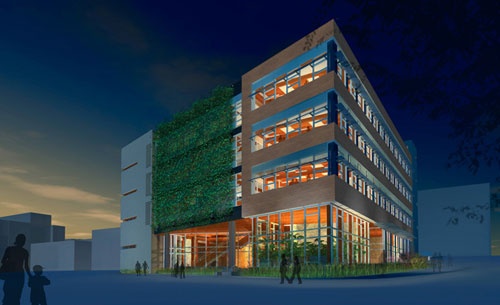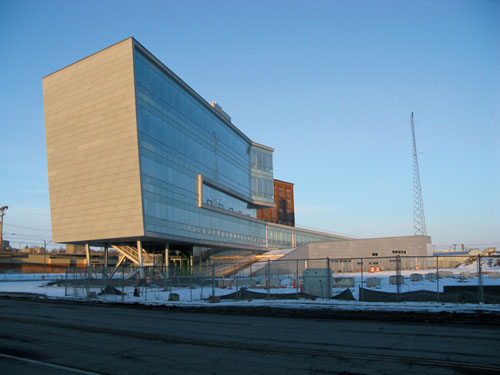The Living Lab
The Interactive Building
The University of British Columbia's Center for Interactive Research on Sustainability (CIRS), due to open its doors September 2011 in Vancouver, is designed to push the boundaries of energy and water efficiency, while involving its inhabitants in the sustainable processes of the facility. The learning experience begins with the approach to the building. A wide swath of green wall cascades down the front facade and flanks the interior space called the Science and Technology Commons. The design team, led by architects Busby Perkins + Will, configured the commons so that many of the green features are visible from the space. A video wall will give a graphic summary of the performance of various features of the building. A "tipping bucket" device will physically demonstrate how much stormwater collected from the building and the site is being added back into the aquifer, after all the building and site requirements have been met.
"Given the imperatives of climate change, the new paradigm [of sustainable design] includes the idea of regeneration in the way we make buildings," says Alberto Cayuela, CIRS associate director. He asserts that the idea behind CIRS is to demonstrate that a laboratory-type building can operate with resources available on-site and be net-positive in energy and water harvesting. Much of the research at CIRS will revolve around the core concept of the facility: That buildings can have a positive impact on the environment through responsible resource management. Another focus of study (like all of the projects in this article) will be to address the gap between the projected performance of sustainable elements and their real-world performance. To this end, the facility will be a rich source of study with its ambitious energy and water systems thoroughly monitored. As is the case with all of the living laboratories projects, CIRS will collaborate with many industry partners in research and green product development.
One of the concepts of CIRS is to engage the inhabitants in the processes of the building. "We use the term 'inhabitant' to underline the concept of buildings as ecosystems—the people in the system aren't just passive users of building infrastructure," Cayuela says. The inhabitants are empowered by giving them the ability to open windows, have access to daylight throughout, and adjust the louvers on the displacement ventilation. In a uniquely democratic twist to the comfort zone, the inhabitants can request temperature adjustments at a special touch screen dashboard. The building systems management software aggregates the requests of the users to assess the temperature for a particular space.
The facility will feature a space called the Group Decision Environment Theater. The decision theater is a new model that uses state-of-the-art interactive digital media to foster the decision-making process by immersing participants in information and graphics. Virtually every vertical surface in the space serves as a projection screen, helping community groups and planners to visualize the environmental impacts of their actions, for example. Conceptually similar to a similar theater at Arizona State University, the CIRS space is designed to be very flexible, with the ability to accommodate many group sizes and configurations.
 |
University of British Columbia's Center for Interactive Research on Sustainability (CIRS) Photo courtesy Perkins + Will |
Like the CIRS project, the Syracuse University Center of Excellence (CoE) headquarters building in Syracuse, New York, uses itself as a teaching tool. Envisioned as a window into green design and research, the public face of the building is clad in high-performance glazing that introduces the building as a transparent and open facility. The intention of the design team, headed by architect Toshiko Mori, was to make an engaging form that invites exploration, according to Ed Bogucz, executive director of CoE. "As one walks from the sidewalk toward the building, one takes a journey," Bogucz says. "Early in the design process we imagined bringing people through a building where all of the systems would be visible," he adds. The building circulation is laid out so that the procession directs visitors to encounter both the sustainable features and the green-based research being conducted in the labs.
The designers put many of the sustainable building systems in a green gallery space where elements such as rainwater collection and mechanical systems are set up as interpretive displays. Visitors can touch the ground-source heat pump pipes to feel the difference between the temperature of the supply line coming up from the ground and the return from the building. "That sensory experience goes far beyond any visual experience in demonstrating the benefits of using the earth for heating and cooling," Bogucz comments.
 |
Syracuse University's Center of Excellence (CoE) Photo © Iwan Baan |









